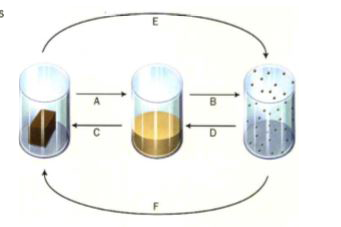Phase transitions are ubiquitous in nature. We are all familiar with the different phase of water (vapour, liquid and ice) and with the change from one to another, the change of phase are called phase transitions. There are six ways a substance can change between these three phase, melting, freezing, evaporating, condensing sublimation and decomposition.
At 1atm pressure vaporisation of 1 mole of water from liquid (75∘C) to vapour (120∘C).
Cv(H2O,l)=75Jmole−1K−1,Cp(H2O,g)=33.3Jmole−1K_1
ΔHvap at 100∘C=40.7KJ/mole
Calculate change in internal energy when
Water liquid at 100∘C to vapour at 100∘C ?
40700J
37598.878J
43801.1J
31012.J
The correct Answer is:B
To calculate the change in internal energy (ΔU) when water changes from liquid at 100°C to vapor at 100°C, we can use the relationship between the change in internal energy and the enthalpy of vaporization (ΔH_vap). Here are the steps to solve the problem:
Step 1: Understand the Phase Change
We are considering the phase transition of water from liquid to vapor at the same temperature (100°C). During this process, the temperature remains constant, and we can use the enthalpy of vaporization to find the change in internal energy.
Step 2: Use the Formula for Change in Internal Energy
The change in internal energy (ΔU) during a phase change at constant temperature can be expressed as:
ΔU=n⋅ΔHvap
where:
- n = number of moles of water (1 mole in this case)
- ΔHvap = enthalpy of vaporization at 100°C (given as 40.7 kJ/mol)
Step 3: Substitute the Values
Given:
- n=1mole
- ΔHvap=40.7kJ/mol=40700J/mol (since 1 kJ = 1000 J)
Now, substituting these values into the formula:
ΔU=1mol⋅40700J/mol
Step 4: Calculate ΔU
Calculating the above expression gives:
ΔU=40700J
Conclusion
Thus, the change in internal energy when water changes from liquid to vapor at 100°C is:
ΔU=40700J
We are considering the phase transition of water from liquid to vapor at the same temperature (100°C). During this process, the temperature remains constant, and we can use the enthalpy of vaporization to find the change in internal energy.
The change in internal energy (ΔU) during a phase change at constant temperature can be expressed as:
ΔU=n⋅ΔHvap
where:
- n = number of moles of water (1 mole in this case)
- ΔHvap = enthalpy of vaporization at 100°C (given as 40.7 kJ/mol)
Given:
- n=1mole
- ΔHvap=40.7kJ/mol=40700J/mol (since 1 kJ = 1000 J)
ΔU=1mol⋅40700J/mol
Calculating the above expression gives:
ΔU=40700J
Thus, the change in internal energy when water changes from liquid to vapor at 100°C is:
ΔU=40700J
Topper's Solved these Questions
- THERMODYNAMICSBOOK - RESONANCE ENGLISHCHAPTER - THERMODYNAMICSEXERCISE - Exercise-3 Part-1: JEE (ADVANCED)
11 Videos
- THERMODYNAMICSBOOK - RESONANCE ENGLISHCHAPTER - THERMODYNAMICSEXERCISE - Main
5 Videos
- THERMODYNAMICSBOOK - RESONANCE ENGLISHCHAPTER - THERMODYNAMICSEXERCISE - Exercise 2- III : One or more than one options correct type
14 Videos
- TEST SERIESBOOK - RESONANCE ENGLISHCHAPTER - TEST SERIESEXERCISE - CHEMISTRY
50 Videos
Similar Questions
Phase transitions are ubiquitous in nature. We are all familiar with the different phase of water (vapour, liquid and ice) and with the change from one to another, the change of phase are called phase transitions. There are six ways a substance can change between these three phase, melting, freezing, evaporating, condensing sublimation and decomposition.
At 1atm pressure vaporisation of 1 mole of water from liquid (75∘C) to vapour (120∘C).
Cv(H2O,l)=75Jmole−1K−1,Cp(H2O,g)=33.3Jmole−1K_1
ΔHvap at 100∘C=40.7KJ/mole
Calculate change in internal energy when
Water liquid at 75∘C to 100∘C ?
View SolutionPhase transitions are ubiquitous in nature. We are all familiar with the different phase of water (vapour, liquid and ice) and with the change from one to another, the change of phase are called phase transitions. There are six ways a substance can change between these three phase, melting, freezing, evaporating, condensing sublimation and decomposition.
At 1atm pressure vaporisation of 1 mole of water from liquid (75∘C) to vapour (120∘C).
Cv(H2O,l)=75Jmole−1K−1,Cp(H2O,g)=33.3Jmole−1K_1
ΔHvap at 100∘C=40.7KJ/mole
Calculate change in internal energy when
Water vapour at 100∘C to 120∘C ?
View Solution
Knowledge Check
Which of the following does not represent enthalpy change during phase transformation?
AStandard enthalpy of fusionBStandard enthalpy of vaporisationCStandard enthalpy of sublimationDStandard enthalpy of formation
Define first order phase transition?
View SolutionThe entropy change for a phase transformation is :
View SolutionHeat supplied to a solid changes it into liquid. What is this change in phase called ?
View SolutionDefine phase and phase difference.
View SolutionWhich phase of prophase-I represents the transition to metaphase I ?
View SolutionWhich is the largest phase of M phase?
View SolutionWrite phase changes in the diagram.

View Solution
